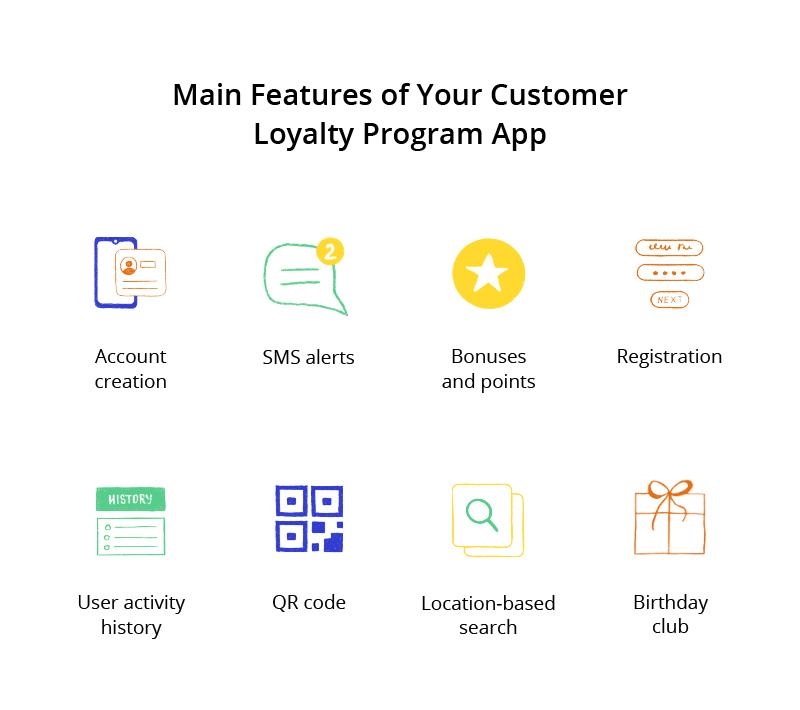The 21st century is tightly bound to total world digitalization. And this trend has also affected such a must-have of modern business as customer loyalty programs in which mobile solutions and big data technologies are being increasingly introduced.
But what are loyalty programs? And how can they be improved with the latest innovations? Let’s take a deeper look at the issue!
What is a customer loyalty program?
As businessmen know, it’s not enough to create a company and attract your target audience... Moreover, it’s not even enough to make its representatives happy with the services (or goods) the business provides! It's also extremely important to keep happy customers and convince them to constantly resort to the help of your company. That's when the loyalty program methodology would come in handy.
In fact, we’re talking about a number of activities aimed at raising clients’ interest in your products or services and increasing his or her desire to buy them on an ongoing basis.
But what is customer loyalty in business? Let’s take a look at a classic approach:
-
Discount program with the issuance of a plastic card (needed to charge discounts).
-
Bonus program. When making a purchase, the client not only gets the desired product (or service) but is also awarded bonuses. Using them, he can purchase certain goods (or order services, depending on the company's nature).
-
Cumulative program as a combination of the above ones. The buyer accumulates points characterizing the total amount of money spent by him in a particular company. Upon reaching a specified level, he gets the right to a bonus, discount, or gift.
Later you'll have a chance to calculate the effects of your loyalty program. But starting a strategy development is better with thoughtful steps. And first of all, make sure the bonus or gift your consumer receives is clear to him. Here are a couple of ideas: a free cup of coffee (if it’s a coffee shop), a large discount on any product or service, etc.

But you must understand: the traditional approach to loyalty programs is almost out of date... it's high time to introduce modern mobile solutions! To convince you, we're ready to describe the main benefits of customer loyalty software.
Why do you need a customer loyalty app?
In our age of high technology, the most reasonable thing to do is to create your own loyalty card app. Why is it a smart step? We’ll give you a few key reasons:
-
Constant contact with the target audience (in 24/7 mode);
-
A simple implementation of the boldest marketing ideas;
-
Real-time tracking of the effectiveness of chosen strategies to increase customer loyalty;
-
Savings on printing discount cards, profiles, other consumables;
-
Ease of use: the consumer doesn’t have to carry a bunch of discount cards;
-
The ability to be creative in designing loyalty program apps;
-
Viral effect. The best customer loyalty program apps are able to make people talk about your company and promote it using the word of mouth effect;
-
Environmental friendliness: one can reduce the use of plastic (needed to create bonus cards) and the consumption of wood (required for printing brochures).
Key types of loyalty programs in mobile solutions
There are a great many different types of loyalty programs, and mobile platforms open up a ton of extra possibilities. We suggest discussing the most crucial approaches.
Points
We should definitely start with points, the basic aspect of loyalty programs of all sorts.
The essence of the points-based loyalty program is quite clear: your client obtains points for visiting your institution and performing some kind of actions (making a purchase, if it's a store or, say, a pharmacy, ordering lunch at a restaurant, etc.) Subsequently, the consumer can use these accumulated points as currency.
Tiers / Levels
Here we’re dealing not with a primitive scheme of accumulating points and exchanging them for currency, but with a system of passing different levels or tiers (as in a game). When the user reaches the next level, he receives a reward (the higher the level, the greater the reward). What tasks to give the consumer so that he moves to a new tier depends solely on your imagination.
Rewarding
Loyalty rewards programs are a logical continuation of the two previous items. The consumer performs certain predetermined actions and gets a reward (which is new points or the right to move to a higher level).
User actions worthy of a reward:
-
purchasing a product or ordering service and paying a certain amount of money;
-
positive feedback on your product or service;
-
visiting your institution a pre-specified number of times (say, at least a hundred);
-
recommendation service to a friend;
-
etc!
Paid loyalty
Participation in these programs isn’t free: the user pays a certain amount of money and gets access to numerous benefits (discounts, promotions, prize drawings, etc.). This is a very effective customer retention strategy because the person who had to fork out obviously plans to stay among your clients.
If you want to develop a successful customer loyalty program of the paid type, consider a few essential aspects:
-
moderate membership fee. Don't ask the consumer to pay too much! Participation in the program should be affordable;
-
worthy reward. Don't skimp on the reward. No one would part with money to get some mythical discounts in the unknown future. Unleash your imagination!
A striking example of the model in question is Amazon with its Amazon Prime: a client enters a paid club and gets a lot of privileges. Participants in Amazon's customer loyalty program gain access to:
-
exclusive sales with impressive discounts;
-
cool movie novelties;
-
a collection of cool books in the Kindle's Library;
-
faster delivery;
-
and much more!
Approaches to designing loyalty program apps
If you intend to build a loyalty app, you should know what basic development options exist.
Aggregators
These loyalty program solutions are targeted at people who have a great many discount cards and therefore they spend a lot of time searching for the right one... and if these searches take place near the cash desk of a store or cafe, everyone gets annoyed.
Surely, such people are most likely to download and install a mobile service in which they're allowed to add their discount cards (of course, you should consider the possibility of a convenient search so that the user is able to find the desired card with ease). Among the examples is the Stocard application, recognized by Apple as the best app for loyalty cards in 2013 (or one of the best).
Single-brand apps
Nevertheless, the best eCommerce loyalty programs are single-brand applications. That's why market giants such as McDonald's, Starbucks, Burger King, and Reebok took an expensive step and created a personalized application to replace their discount cards (you must agree, finding the right app on your smartphone’s desktop is easier than attempts to locate a card in your wallet).
Of course, the task to build a loyalty app and promote it isn't cheap, but these costs are justified.
Successful loyalty programs examples
We guess, it’s time to discuss the most successful loyalty programs on the mobile market: both single-brand apps and services, which can be used by different companies.
Starbucks
Starbucks is an illustrious coffee chain operating in many countries around the world. Its owners are following all modern technologies; among other things, they created their own mobile service, which has become one of the most popular loyalty programs apps.
Starbucks offers users the following options:
-
Accumulation of points, presented in the form of stars in the Starbucks rewards program: when a client gains a certain number of stars, he gets the right to order a free drink. Of course, that’s only possible if the cafe visitor pays using the official Starbucks app.
-
Payment using a mobile device (just scan the QR code on the smartphone screen). However, we'll discuss the topic of mobile payments later in the article.
-
The so-called eGifts: special presents that Starbucks clients can send to their friends via email.
Shopkick
Shopkick is on the list of the top loyalty apps in shopping, and the number of its users is already reckoned by millions.
Shopkick provides users with…
-
Accumulation of points that Shopkick calls kicks. To get another kick, the user must perform a certain action (visiting a point of sale, scanning a purchase via a mobile device, etc.). The accumulated “kicks” can be exchanged for a present, whether it be movie tickets, gift cards, or anything else no less pleasant.
-
Location-based hints and tips. The application locates users and shows which partner stores are nearby. Also, a user can see what products he might purchase there. Among Shopkick's partners are Target supermarket chain, P&G and L’Oreal, Best Buy electronics stores, and so on.
Sephora
When describing efficient and useful customer loyalty programs apps, we can't neglect Sephora, the application selling perfume and cosmetics. As soon as the user has installed the mobile service and registered in it, he gets 5 points on his discount card. Subsequent points are being awarded for each completed purchase and can serve as a kind of exchange currency allowing to get some kind of gift.
Belly
Belly is another popular app for a customer loyalty program. Launched in 2011, today it cooperates with more than 6 thousand sellers. Unfortunately, only companies in the USA can take advantage of it.
To receive the award, the user must scan the QR code of the mobile application by bringing it to the tablet installed in the partner institutions of the Belly system.
ASOS
ASOS is a UK multi-brand clothing store. Every week, the ASOS assortment is being replenished with 900+ trendy fashion merchandise. Its head office is located in Barnsley. ASOS is widely known not only in Europe but also throughout the world.
ASOS has its own loyalty app for business purposes. The loyalty program is aimed at regular customers from England who receive bonuses when making purchases. The more bonuses a client has accumulated, the higher his status in the program. These buyers get:
-
birthday discounts;
-
access to presale of trend collections;
-
double or triple bonuses on certain days of the year;
-
invitations to exclusive sales.
Juengo
Juengo is another example of successful customer loyalty programs. If an app user performs certain actions, Juengo rewards him with virtual points, which he is allowed to exchange to purchase goods. These actions include the following options:
-
newsletter subscription;
-
scanning a QR code at an event or at the entrance to the store;
-
clicking the Like button.
At the moment, the application works only in the USA and Greece.
Nike
There is no need to represent Nike: everyone has probably heard of this global manufacturer of sportswear and shoes. The brand’s glory is well deserved: during long years the company has been working diligently to win the love of its clients. That's why it has recently focused on proper digitalization.
Nike has its own application, which belongs to the most popular loyalty programs. Among the reasons explaining such popularity is the fact that Nike makes each user a unique personalized offer based on data obtained and analyzed about him.
Of course, Nike is constantly trying to improve its customer loyalty app. For instance, it has added a new feature: now the program recognizes the user entering the store and shows him the products he is most likely to be interested in. Another advantage provided by Nike's service is the possibility to pay for purchases online (which means no queuing!).
Features of a customer loyalty program app
-
Registration and account creation. Registration is an obvious step in designing mobile loyalty programs, right? The user must sign up and create his account with personal information and the possibility to manage settings.
-
QR code. Don’t forget about the unique QR code assigned to each user in order to identify him or her. The QR code has several important functions:
-
Bonus accrual. Let's say a client comes to a cafe, orders coffee, and says that he has a special loyalty mobile app installed. The cafe's system reads the information using a QR code and charges the customer a certain number of points.
-
Convenient payments. A QR code is also a great opportunity to simplify the payment process. This is exactly what Starbucks is doing to increase customer loyalty (as we've mentioned above). Another example is a famous LevelUp solution working through the Braintree payment gateway and allowing companies to accept money transfers using QR-code technologies.
-
-
Bonuses and points. Surely, the loyalty app functionality cannot but include the system of charging and writing off bonuses and points to the user.
-
Push notifications & SMS alerts. One of the perks of creating a loyalty program app for small businesses (or large ones) is an opportunity to stay in touch with your target audience in 24/7. There are a lot of ways to communicate with your users, and the most obvious option is through all sorts of notifications. Take a look at the most popular cases when it'd be wise of you to send pushes or SMS:
-
Geolocation. If the user allowed your application to determine his location, you can send him messages when he is near your establishment (say, "We have a sale, come in!");
-
Important news. Inform the consumer about news regarding your loyalty mobile app: functionality updates, new discount systems, etc.
-
-
Location-based search. Using GPS features makes it possible to solve several problems and encourage customer loyalty:
-
sending smart notifications (when and why you need to send them we wrote in one of the items above);
-
giving the user the opportunity to find the nearest establishment of your chain system: if he wants to visit a pharmacy or cafe (or whatever) nearby.
-
-
Birthday club. We think you know that almost all people like to receive birthday presents. And you, too, can please your customers on such a day by providing discounts or other pleasant surprises (how about a free lunch if you are the owner of coffee or 50% on all purchases?).
-
User activity history. Of course, the feature isn't mandatory, though it’s a good option: best loyalty programs apps provide users with access to the archive of all operations performed by him.

How to build customer loyalty programs?
We've discussed all the important aspects of the issue except one: how to generate efficient strategies for designing loyalty program apps? In other words, what should you consider in the development process?
-
Examine each of your customers. To be of service to your clients, you must be aware of their needs and expectations. It means you need to provide enough time to collect and analyze data on every user.
-
Make personalized offers. Remember: according to research, almost 65% of people want to receive personalized offers. The rule is being followed by all successful customer loyalty programs: the same Starbucks uses the customer’s purchase history to be able to give him a few helpful tips and recommendations. By the by, without the collection and analysis of the data that we've discussed in the item above, you’re unlikely to meet the needs of your clients.
-
Take advantage of gamification, which is the use of the basic principles of the gaming industry: accumulation of points, ratings, progress indicators, difficulty levels, competitions between participants, winner rewards, and so on. To be precise, it’s about a kind of quest, the essence of which is to earn points and pass levels. The game acts as a motivator, attracting the attention of the client and convincing him to test a new product or service, evaluate its benefits, and use it in the future. So be sure to resort to this great principle if you really want to design a loyalty app and succeed.
-
Let users manage their points, rewards, and bonuses themselves. That is, the client must be able to decide where and when to spend legally earned points.
-
Update and improve. Don’t stop working on your loyalty app functionality by adding new features and bettering existing ones.
Summary
Now you understand how to keep customers loyal with innovative digital solutions. Follow our tips and your strategy will lead the company to success and prosperity.



